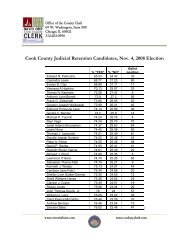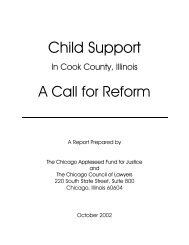Videoconferencing in Removal Hearings: A Case Study of the ...
Videoconferencing in Removal Hearings: A Case Study of the ...
Videoconferencing in Removal Hearings: A Case Study of the ...
You also want an ePaper? Increase the reach of your titles
YUMPU automatically turns print PDFs into web optimized ePapers that Google loves.
After compil<strong>in</strong>g our data, we shared it with a multi-discipl<strong>in</strong>ary advisory board, and<br />
<strong>in</strong> consultation with <strong>the</strong> board, we developed a series <strong>of</strong> recommendations for <strong>the</strong> future<br />
use <strong>of</strong> videoconferenc<strong>in</strong>g <strong>in</strong> immigration court.<br />
1. Impos<strong>in</strong>g a general moratorium on videoconferenc<strong>in</strong>g<br />
Our f<strong>in</strong>d<strong>in</strong>gs suggest that videoconferenc<strong>in</strong>g <strong>in</strong> <strong>the</strong> Chicago Immigration Court<br />
underm<strong>in</strong>es <strong>the</strong> fairness <strong>of</strong> <strong>the</strong> judicial process. The use <strong>of</strong> videoconferenc<strong>in</strong>g is marked<br />
by persistent problems with equipment, presentation <strong>of</strong> evidence, access to counsel,<br />
<strong>in</strong>terpretation, and assessment <strong>of</strong> credibility. <strong>Videoconferenc<strong>in</strong>g</strong> is widely disliked by<br />
immigrants’ attorneys. Although we were largely unable to <strong>in</strong>terview deta<strong>in</strong>ed<br />
immigrants, relevant studies suggest that videoconferenc<strong>in</strong>g has <strong>the</strong> potential to<br />
underm<strong>in</strong>e <strong>the</strong> perception <strong>of</strong> immigrants that <strong>the</strong>y are receiv<strong>in</strong>g fair process. If EOIR is<br />
to cont<strong>in</strong>ue to use videoconferenc<strong>in</strong>g, it must seriously reform current practices. This<br />
process will take time; and while EOIR studies <strong>the</strong> issue, and undertakes comprehensive<br />
rulemak<strong>in</strong>g, it is unfair to immigrants currently <strong>in</strong> removal proceed<strong>in</strong>gs to subject <strong>the</strong>m to<br />
a defective system.<br />
Recommendation: If videoconferenc<strong>in</strong>g is to rema<strong>in</strong>, EOIR must improve and<br />
regulate it better. In <strong>the</strong> meantime, EOIR should impose a moratorium on <strong>the</strong> use <strong>of</strong><br />
videoconferenc<strong>in</strong>g <strong>in</strong> removal hear<strong>in</strong>gs to prevent immigrants from be<strong>in</strong>g unjustly<br />
removed because <strong>of</strong> current deficiencies.<br />
2. Provid<strong>in</strong>g regulatory guidance and comprehensive tra<strong>in</strong><strong>in</strong>g for <strong>the</strong><br />
implementation <strong>of</strong> videoconferenc<strong>in</strong>g<br />
Current EOIR regulations provide no real guidance for <strong>the</strong> use <strong>of</strong><br />
videoconferenc<strong>in</strong>g and no standards as to when it should not be used. EOIR tra<strong>in</strong><strong>in</strong>g<br />
materials focus on issues <strong>of</strong> sound quality and jurisdiction (<strong>in</strong> many cases an immigrant is<br />
51




